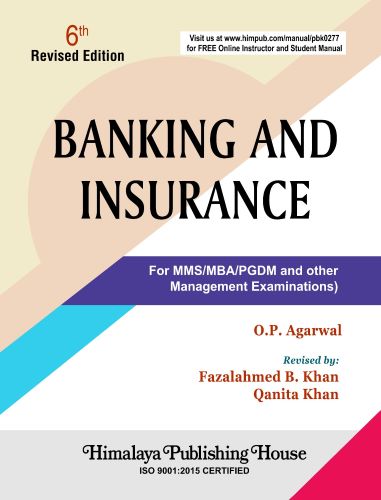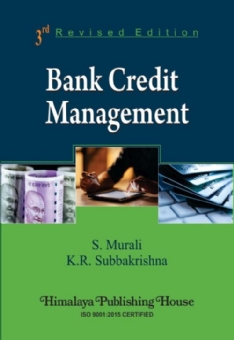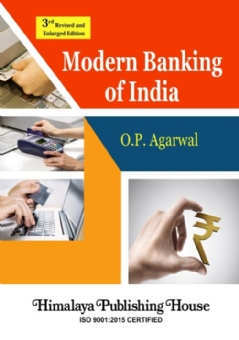During worldwide recession of 2008, India suffered a least but had a unprecedented change in its financial architecture. Globalisation has not only the mass availability of large number of alternative products/financial services. But this also brought harmful products like toys and similar things which were extremely harmful to children due to its contents of chemicals.
Subjects like NPAs and RRBs have been enlarged and take over of RRBs by new bank licence-holder may relieve the Central and State Governments from running of rural banks and making available the financial services to rural population with latest mechanised methods.
Contents :
1. Evolution of Banking
1.1 Evolution of Commercial Banking Business in India, 1.2 Era of Nationalization and After (1969 to 1991), 1.3 Era of Economic Reforms (1992 to 2003) 1.3.1 From 2004 to Date, 1.4 Rural Banking System 1.4.1 Inception of Cooperative Banks 1.4.2 Structure of Cooperative Credit Institutions 1.4.3 Regulating Cooperative Banks 1.4.4 Land Development Banks 1.4.5 Regional Rural Banks (RRBs) 1.4.6 Local Area Banks (LABs), 1.5 Traditional Banking Functions 1.5.1 Accepting Deposits 1.5.2 Basic Savings Bank Deposit Account (BSBDA) 1.5.3 Loans and Advances 1.5.4 Sound Lending
2. Role of Commercial Banking
2.1 Importance of Banks, 2.2 What is a Bank? 2.2.1 Economic Development and Banks 2.2.2 Regulatory Framework and Banks 2.2.3 Move Towards Becoming High Performing Organisations, 2.3 Role of Banks in Economic Development 2.3.1 Rating of Banks, 2.4 Risk Management 2.4.1 Measures for Foreign Risk Management 2.4.2 Internal Techniques 2.4.3 External Techniques 2.4.4 Categories of Derivatives 2.4.5 Credit Derivatives 2.4.6 Introduction to Option Valuation 2.4.7 Risks in National and International Banking, 2.5 Role of Public Sector in Banking, 2.6 Reforms in the Banking Sector, 2.7 Mobile Banking 2.7.1 Mobile Communication Technologies 2.7.2 Mobile Banking Business Models 2.7.3 Mobile Transaction Architecture 2.7.4 Mobile Banking Services 2.7.5 Advantages of Mobile Banking 2.7.6 Electronic Funds Transfers 2.7.7 Advantages 2.7.8 EFT in India, 2.8 Financial Reforms and Banking Delegation 2.8.1 Financial Disintermediation 2.8.2 Demographic Shift, 2.9 Evaluation of Banks, 2.10 New Banking Order, 2.11 Banking on Innovation by the Year 2040, 2.12 Expansion of Banking and Financial Inclusion in India
3. Structure, Growth and Development of Banking
3.1 Corporate Banking, 3.2 Role of Banks, 3.3 Developments in Indian Banking: Past, Present and Future, 3.4 Towards Building High Performing Organisations, 3.5 Financial Holding Company Structure Model, 3.6 Banks to Fund Infra Projects, 3.7 Governance of Banking and Financial Services, 3.8 Key Elements of Corporate Governance Structure, 3.9 Infotrends and Indian Banking Industry, 3.10 Banking Ombudsman Scheme, 2006, 2009 and 2021, 3.11 Islamic Development Bank
4. Study of Commercial Banks’ Balance Sheet and Profit and Loss Account
4.1 Comparison of Medium, Small and Large Banks, 4.2 Profitability Management, 4.3 Liquidity Management, 4.4 Interest Rate Risk Managemenet, 4.5 Capital Account Management, 4.6 Credit Risk Management, 4.7 Cost Management, 4.8 FDI Rules for Pension Investment
5. Treasury and Funds Management in Banks
5.1 Introduction, 5.2 Emergence of Unified Financial Market, 5.3 Functions of Treasury Management, 5.4 Organisational Structure of Treasury in Banks, 5.5 Pricing of Assets and Liabilities of Bank, 5.6 Capital Allocation and Optimisation of Business for Banks through RAROC, 5.7 SLR – Investments, 5.8 Non-fund-based Income, 5.9 Structured Business of the Bank, 5.10 Off-balance Sheet Transactions
6. Risk Management in Banks
6.1 Changing Scenario of Risk Management, 6.2 Types of Risk in Banks
6.2.1 Capital Allocation for Operational Risk 6.2.2 Managing Off-balance Sheet Exposure, 6.3 Financial/Liquidity/Market Risk Mitigation 6.3.1 Mitigation of Basis Risk 6.3.2 Value at Risk (VaR), 6.4 Risk Management in Banks 6.4.1 Asset Liability Pricing 6.4.2 Forex (Market) Risk 6.4.3 Credit Risk Exposure Measurement, 6.5 Possible Risks Faced by a Bank, 6.6 Sources of Risk, 6.7 Measures for Identifying and Controlling Risks 6.7.1 Market Risk 6.7.2 Gap Analysis 6.7.3 Liquidity Risk 6.7.4 Credit Risk 6.7.5 Operational Risk
7. Assets-Liabilities Management
7.1 Overview, 7.2 Achievement of Objectives, 7.3 Prerequisites for ALM 7.3.1 Framework of Policy 7.3.2 Credit Policy 7.3.3 Investment Policy 7.3.4 Liquidity Policy 7.3.5 Interest Rate Sensitivity Policy, 7.4 Assets and Liabilities Committee (ALCO) 7.4.1 Activities of ALCO 7.4.2 ALCO Meetings 7.4.3 Role of Information Technology, 7.5 Non-performing Assets (NPAs) 7.5.1 Gross NPA and Net NPA 7.5.2 Past Due 7.5.3 Income Recognition 7.5.4 Reporting of NPAs 7.5.5 Temporary Deficiencies in Account 7.5.6 Categories of NPAs 7.5.7 Valuation of Investments 7.5.8 Agricultural Advances Provisions on Standard Assets under Direct Agri SME – 0.25% 7.5.9 Signs of NPAs Moderating and Declining Trend of Provisions 7.5.10 Reasons for NPAs in Priority Sector Advances 7.5.11 Reasons for NPAs in Non-priority Sector Advances, 7.5.12 Credit Management — Fund-based
8. Role of Reserve Bank of India
8.1 Role of RBI, 8.2 Reserve Bank of India: Organisation and Functions .2.1 RBI and its Credit Policy 8.2.2 Regulatory Aspects of RBI 8.2.3 Role of Reserve Bank of India 8.3 Major Powers 8.4 Amalgamation 8.5 Winding Up of Banks 8.6 Power to Impose Penalties 8.7 Role of Comptroller and Auditor General of India (C&AG)
9. Cooperative Banks/Regional Rural Banks and Rural Banking
9.1 Concept of RRBs, 9.2 Some Prominent Provisions of the RRB Act, 9.3 Number of RRBs and their Branches, 9.4 Capital of RRBs, Shareholding in RRBs, 9.5 Functions of RRBs, 9.6 Sponsor Banks of RRBs and Respective Number of RRBs, (2021), 9.7 Reorganization of RRBs Over the Years, 9.8 Major Financial Indicators of Regional Rural Banks — State-wise 2020-21, 9.9 Financial Performance of Regional Rural Banks, 9.10 Rural Money Market in India, 9.11 Board of Directors, 9.12 Management of RRBs, 9.13 RBI Tightens Anti-Money Laundering Norms for RRBs, 9.14 Cooperatives to Offer Home Loans, 9.15 Performance and Challenges of Urban Cooperative Banks in India, 9.16 Developments of Urban Cooperative Banks in India — A Brief Review, 9.17 Classifications of UCBs/Tier-wise Distribution, 9.18 Consolidation of Urban Cooperative Banks and SWOT Analysis, 9.19 Umbrella Organization for Urban Cooperative Banks 9.19.1 Board of Management in UCBs, 9.20 Failure of Some Big Cooperative Banks and Legal Response to it 9.20.1 Aftermath of the collapse of PMC Bank, 9.21 Amendments to Banking Regulation Act in 2020 9.21.1 New Regulatory Measures Introduced, 9.22 Recommendations of the Expert Committee of RBI of UCBs (2020-21), 9.22.1 Recommendations of the Expert Committee of the RBI (2021) and their Acceptance, 9.23 Financial Performance of Scheduled and Non-scheduled Urban Cooperative Banks, 9.24 Rural Banking in India
10. Banking Reforms
10.1 Reforms in General 10.1.1 Reforms in Banking Sector 10.1.2 Financial Sector Reforms (Phase I) — Narasimham Committee 1991, 10.2 Banking Sector Reforms Committee — Narasimham Committee II, 1998 10.2.1 Taking into Account Market Risk 10.2.2 Bringing Down the Level of Net NPAs 10.2.3 RBI’s Response to the Report as Action Taken Report (ATR) and Action Till 2022 (Excerpts] 10.2.4 Consolidation of Banks 10.2.5 Capital Adequacy Ratio 10.2.6 Licensing Policy 10.2.7 Adoption of I.T., I.C.T and Networking Systems 10.2.8 Legal Reforms in Banking Sector 10.2.9 Recapitalization of Banks, 10.3 Legal Reforms during the Last Two Decades, 10.4 Major Initiatives in Banking Sector 10.4.1 Banking Correspondents 10.4.2 Differentiated Banks 10.4.3 Big Push to Financial Inclusion, 10.5 Consolidation in Banks, 10.6 Consolidation of Associate Banks of SBI into it: Mergers of Nationalized Banks
11. Basel-II and Basel-III Implications for Indian Banks
11.1 Implications, 11.2 Basel-II and Basel-III Credit Risk, 11.3 Internal Credit Rating Models of Banks: A Survey of Indian Banks, 11.4 Who Assigns Rating?, 11.5 What Risk Factors are Considered?, 11.6 Review of Ratings, 11.7 Mapping of Internal Ratings with External Ratings, 11.8 Definition of Default, 11.9 Predictive Power of Financial Risk Factors, 11.10 Actions for Improving the Quality of Loan Portfolio, 11.11 Risk Pricing, 11.12 Criticisms of International Credit Ratings of Nations
12. Asset Reconstruction Company
12.1 Genesis of ARCs in India, 12.2 International Experience of ARCs, 12.3 Legal Framework, 12.4 Functioning of ARCs, 12.5 National Asset Reconstruction Company Ltd. and India Debt Resolution Company Ltd (IDRCL), 12.6 Purgatorial Push by RBI (IB Code), 12.7 Clearing the NPA Mess, 12.8 Revised Regulatory Framework for Asset Reconstruction Companies (ARCs): (RBI Notification dated 11 October, 2022).
13. Securitisation Act, 2002
13.1 Concept of Securitisation, 13.2 Who Can Securitise? The Process and Participant, 13.3 Impact on Banking, 13.4 Special Types of Securitisation, 13.5 Motives for Securitisation — Nine Advantages to Issuer, 13.6 Advantages to Investors, 13.7 What Can be Securitised?, 13.8 Registration under the Act, 13.9 Financial Assets which can be Sold, 13.10 Provisions of Act Does Not Apply To, 13.11 Indian Securitisation Market and Asset Classes in India, 13.12 Securitised Debt Market: A New Regulatory Landscape by SEBI
14. Project Financing and Working Capital Finance
14.1 Definition of Project Financing, 14.2 Advantages of Project Finance, 14.3 Bridge Financing, 14.4 Clearance of Export Proposals, 14.5 Role of ECGC, 14.6 Different Risks in Project Exports, 14.7 Working Capital Finance, 14.8 Meaning of Working Capital Finance, 14.9 Operating Cycle, 14.10 Factors Affecting Working Capital, 14.11 Inventory Management, 14.12 Receivable Management, 14.13 Assessment of Working Capital Needs, 14.14 Methods for Computation of Working Capital, 14.15 Basel-II and Project Finance
15. Banking through Information Technology
15.1 e-Business, 15.2 e-Commerce, 15.3 e-Banking, 15.4 Electronic Money (e-Money), 15.5 Online Banking, 15.6 Real Time Gross Settlement (RTGS), 15.7 Structured Financial Messaging System (SFMS), 15.8 Clearing House Interbank Payment System (CHIPS), 15.9 Society for Worldwide Interbank Financial Telecommunication (SWIFT), 15.10 National Automated Clearing House (NACH) for Banks, 15.11 Cheque Truncation System, 15.12 Major Networks for Data Communication, 15.13 VSAT Network in India, 15.14 Digital Signature, 15.15 Telebanking, 15.16 Anytime Banking, 15.17 Anywhere Banking, 15.18 Home Banking (Corporate and Personal), 15.19 e-Payment Gateway
16. Priority Sector Lending
16.1 Genesis, 16.2 Current Guidelines, 16.3 Description of Eligible Categories under Priority Sector, 16.4 Inter-bank Participation Certificates (IBPS) (Not applicable to UCBs), 16.5 Consequence of Non-compliance of the PSL Targets, 16.6 Common Guidelines for Priority Sector Loans, 16.7 Status of Priority Sector Lending in 2020-21, 16.8 Pre-shipment or Packing Credit, 16.9 Post-shipment Finance, 16.10 Imports into India, 16.11 External Commercial Borrowings
17. Banking Legislation
17.1 Banking Regulation Act, 1949, 17.2 Reserve Bank of India Act, 1934, 17.3 Negotiable Instrument Act, 1881
18. Introduction to Insurance
18.1 What is Insurance?, 18.2 Advantages and Disadvantages of Insurance, 18.3 Principles of Insurance, 18.4 Elements of Insurance Contract, 18.5 Kinds of Insurance 18.5.1 Miscellaneous Insurance 18.5.2 Types of Travel Insurance 18.5.3 Insurance Cover for Domestic Travellers 18.5.4 Office Umbrella Policy 18.5.5 Personal Accident Insurance 18.5.6 Rural Insurance 18.5.7 Agriculture Insurance 18.5.8 Crop Insurance Scheme 18.5.9 ‘Micro-insurance’ in India — Opportunities and Challenges 18.5.10 Health Insurance
19. Growth and Development of Insurance in India
19.1 History of Insurance in India and Formation of LIC & GIC, 19.2 Formation and Structure of LIC/GIC 19.2.1 IRDA to Form Benchmarks 19.2.2 Establishments Overseas 19.2.3 Structure of GIC, 19.3 Reinsurance Business in India, 19.4 Global Reinsurers’ Capitalisation, 19.5 India’s Share of World Life Insurance, 19.6 Revival of Policies and Claims, 19.7 Insurance Frauds and Risk and Loss Mitigation
20. Range of Products and Services of Insurance
20.1 Available Products, 20.2 New Products for Changing Risk Pattern, 20.3 Risks Relating to New Technologies, 20.4 Political Risk, 20.5 Environmental Risk, 20.6 Health Care Services, 20.7 Loss of Profit Cover, 20.8 Responsibilities under Various Laws in India, 20.9 Insurance against Unforeseen Circumstances, 20.10 Better Exploitation of Existing Products, 20.11 Personal and Institutional Coverage, 20.12 File and Use Procedure
21. Fund Management in Insurance Sector
21.1 Investment Management, 21.2 Objectives in Fund Management, 21.3 Nature of Fund Investment, 21.4 Investment in Stock Market, 21.5 Development of Expertise 21.5.1 Responsibility of Top Management 21.5.2 Regulations for Insurance Investment 21.5.3 Mandated Decisions in Investment
22. Insurance Regulatory and Development Authority (IRDA)
22.1 Constitution of the IRDA, 22.2 New Regulations, 22.3 Policyholders’ Interests, 22.4 Bancassurance in India 22.4.1 Current Scenario of Bancassurance in India 22.4.2 Solvency Margin Norms 22.4.3 IRDA and Quarterly Solvency Reports, 22.5 Positive Approach in Regulation, 22.6 Influence of Other Laws in India
23. Insurance Distribution Channels
23.1 Introduction, 23.2 Landscape of the Insurance Broking Industry, 23.3 Bancassurance in India 23.3.1 Benefits of Bancassurance 23.3.2 Bancassurance Arrangement 23.3.3 Rationale for a Bancassurance Agreement 23.3.4 IRDA’s Latest Rules – An Attempt to Clean Up Bancassurance
24. Policy Values
24.1 Present Value of Policies, 24.2 Two Kinds of Policy Values, 24.3 Policy Value in Symbols, 24.4 Calculation of Policy Value for Unit Sum Assured, 24.5 Retrospective Method and Comparison with Prospective Value, 24.6 Derivation of Theoretical Expressions for Policy Value, tVx, by the Retrospective Method and Prospective Method, 24.7 Other Expressions for Policy Value, 24.8 Surrender Values, 24.9 Paid-up Policies, 24.10 Alteration of Policy Contracts, 24.11 Case Studies
25. Methods of Valuation
25.1 Valuation of Liabilities, 25.2 Prospective Method of Valuation, 25.3 Methods of Valuation, 25.4 Net Premium Method of Valuation, 25.5 Modified Net Premium Method of Valuation, 25.6 Gross Premium Method of Valuation, 25.7 Gross Premium Method for With-profits Policies, 25.8 Gross Premium Bonus Reserve Method of Valuation, 25.9 Special Use of Retrospective Method
26. Data of Valuation
26.1 Servicing of Policies, 26.2 Computer Programs, 26.3 Additional Term, 26.4 Valuation of Non-standard Plans
27. Underwriting of Life Insurance
27.1 Proposal for Insurance, 27.2 Financial Underwriting, 27.3 Underwriting by Brokers, 27.4 Recent Trends, 27.5 Insurance Documents, 27.6 First Premium Receipt (FPR), 27.7 The Policy Document, 27.8 Policy Conditions, 27.9 Lapse and Non-forfeiture, 27.10 Paid-up Value, 27.11 Revival of Policy, 27.12 Assignment of Policy, 27.13 Surrenders and Loans
28. Insurance Marketing
28.1 Purpose of Marketing, 28.2 Target Segments, 28.3 Strengthening Relationships, 28.4 Advertisements, 28.5 Keeping Customer Happy
29. Underwriting of General Insurance
29.1 Term — Underwriting Defined, 29.2 Specified Perils vs. All Risks, 29.3 Conditions for Policy Contract, 29.4 Warranties, 29.5 Proposal Forms, 29.6 Agreed Bank Clause, 29.7 Marine Cargo Insurance, 29.8 Miscellaneous Insurance (Burglary Insurance)
30. Laws Relating to Insurance Business
30.1 Introduction, 30.2 Insurance Act, 1938, 30.3 Insurance Regulatory and Development Authority Act, 1999, 30.4 IRDA Regulations, 2002 (Protection of Policyholders’ Interests), 30.5 Consumer Protection Act, 2019
Bibliography









